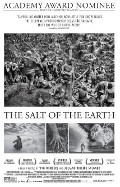
Directed by
Wim Wenders / Juliano Ribeiro Salgado
110 minutes
Rated M
Reviewed by
Sharon Hurst

Salt Of The Earth, The
Synopsis: A documentary dealing with the life of Brazilian photographer, Sebastiao Salgado, who has travelled the world for 40 years taking the most remarkable photos.
Recently Finding Vivian Maier introduced us to a photographer whose work depicted the human condition with extraordinary insight. Now this riveting film about social documentary photographer and photojournalist Sebastiao Salgado reveals again the power of photos to move us and shape our perception of the world.
We learn that Salgado came from a Brazilian cattle farm. A very sketchy outline of his early life tells us he trained in economics and at 23, in 1967, married an architect, Lelia, who was to be pivotal in helping him in his work. Exactly how he moved into photojournalism isn’t detailed but the film, although not chronological, follows Salgado’s fascinating journey which in some measure is ordered by titles indicating the year and where the photos were taken.
So we have his first African expedition to Niger in 1973. He then spent seven years on a project titled “Other Americas”, featuring the rural people of far-flung areas in South America. He went on to work with humanitarian organisation Medecins Sans Frontières documenting the devastating droughts and famines in Africa. Years later Salgado chronicled the brutal war in Rwanda, more famine in Ethiopia and Mali, and later again the oil-well fires in Kuwait during the Gulf War. He documented brutality in the former Yugoslavia and declared that everyone should see his photos to realize how terrible the human species really is.
The photos appear on the screen in arresting and often overwhelmingly powerful black and white clarity. The opening shots taken in a Brazilian open-cut gold mine are like nothing I’ve ever seen. I wanted to have a remote control to simply stop the film and absorb the power and awesomeness of each shot. In between the many horrific images that Salgado captured are many that inspire whilst there are also personal images such as those of his second son, Rodrigo, born with Down Syndrome. There is also time for an adventurous photo shoot involving walruses and a polar bear accompanied by first son, Juliano, the co-director with Wim Wenders of this film.
Wenders, himself a photographer and director of visually stylish films like Wings Of Desire and Paris, Texas, knows how to present the subject matter to its best effect on screen. The projection of the images to screen-size, sometimes using Salgados’ image superimposed, reminiscing about particular photos and their place in a sad and sorry history, is a powerful device. Salgado’s voice-over reveals a man with not only an extraordinary eye for his subject, but also a keen analytical mind and a depth of compassion. The pairing of such a distinctive director with this marvellous photographer is truly a match made in heaven.
Having seen so much of human suffering Salgado returns to Brazil to find the effects of drought have devastated his childhood farm, but, again inspired by Lelia, he decides to revegetate and another massive project is born. In between the tree planting Salgado picks up his camera, travelling another eight years observing nature: gorillas, Galapagos turtles, remote Inuit tribes and native peoples who have barely been in contact with the modern world. His childhood farm is now the Instituto Terra, devoted to environmental education and ecosystem regeneration. The land he has restored is a national park and a model of hope in resuscitating abused land.
The Salt Of The Earth is a true eye-opener and brilliantly demonstrates how a single image can teach us more than any lecture could. It is a film I can’t wait to revisit.

Want more about this film?


Want something different?




